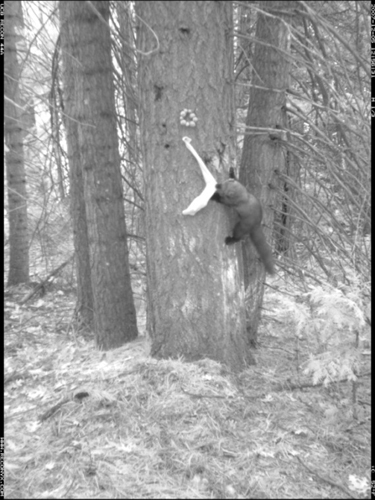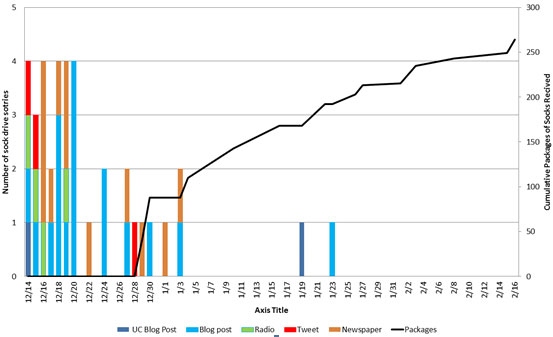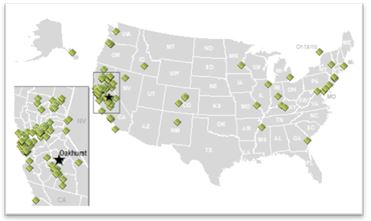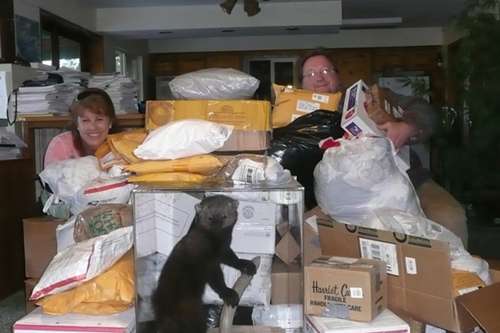 |
February 2013
|
February 2013 // Volume 51 // Number 1 // Ideas at Work // v51-1iw3
Using Social Media to Involve the Public in Wildlife Research—the SNAMP Fisher Sock Collection Drive
Abstract
The University of California Cooperative Extension used social media to solicit donations to support research on the Pacific fisher, a rare forest-dwelling weasel, conducted by UC scientists. The social media campaign included blog and Facebook postings, news releases, and tweets requesting donations of single socks. Socks were donated from around the state and nation, with 82% coming from urban areas. The drive was successful at securing resources to support wildlife research while at the same time extending outreach to new non-local audiences. The major challenge was developing the local logistical support to deal with the overwhelming influx of donations.
Project Background
This article reports on an innovative social media project organized by a local county-based University of California Cooperative Extension (UCCE) program in the rural community of Oakhurst, California, population 3,000. UCCE, as part of an innovative collaboration called the Sierra Nevada Adaptive Management Project (SNAMP), is conducting outreach for a 7-year, $12 million study of the effects of forest thinning in national forests on wildlife, water, forest health, wildfire behavior, and public involvement (http://snamp.cnr.berkeley.edu).
One component of SNAMP is a camera survey across a 500-square-mile area of the Sierra National Forest to determine the distribution of the Pacific fisher (Martes pennanti), a rare weasel. Research results will be used to promote more effective management of wildlife habitat for this old-growth dependent species on national forests in the Sierra Nevada. Revised forest management may cause some social and economic consequences to nearby communities much like management for the California spotted owl caused nearly two decades ago. UCCE goals for outreach about the fisher are to involve local communities in wildlife research in order to improve the social acceptability of needed management changes; and to educate the regional and national audience on the needs of this carnivore. However, research on rare species can be considered sensitive and involving the public in a substantive way can be very challenging.
SNAMP researchers developed an innovative way to involve the public in fisher research and at the same time reduce costs through the donation of used socks. Researchers use socks as a receptacle for hanging bait in view of motion-activated cameras. Animals climb bait trees to chew on the bait while a camera takes digital images that allow scientists to identify them (Figure 1). SNAMP researchers use about 200 pairs of socks a month.
Figure 1.
Pacific Fisher Chewing on a Bait Sock in Front of a Motion-Detection Camera

Use of Social Media for the Fisher Sock Drive
The sock drive began in November 2011 with development of a humorous one-page flyer appealing for sock donations. The flyer explained the need for used socks in support of research on the fishers and had an image of a fisher pulling on a bait sock. The flyer and sock drop-off bins were distributed to local schools in Oakhurst, the headquarters of the research team. This approach yielded only a few hundred socks. Organizers then decided to use social networking methods to widen the scope of the appeal. The goals of the social media campaign were to solicit donations of materials to help support fisher research and to extend outreach to new non-local audiences across the state, region, and nation. The sock drive appeal was posted on University of California Agriculture and Natural Resources social media sites, including the UC Green Blog (http://ucanr.org/sockdrive), Facebook page (https://www.facebook.com/ucanr), and was Tweeted all on December 14th, 2011. A UC news release was posted (http://ucanr.edu/News/) and sent to the news media on December 15th. Another tweet about the sock drive was sent on December 28th.
Sock Drive Results
The response to the social media campaign overwhelmed our expectations. The UC Green Blog story received over 10,000 hits by January 30th 2012, the most of any story since its inception in July 2010. The post led to interviews on four radio stations and articles in California newspapers, including the San Francisco Examiner, Sacramento Bee, and San Jose Mercury News. Most media stories occurred during the first 2 weeks after the initial appeal was posted (Figure 2).
The social and traditional media attention led to a tremendous influx of socks. Over 282 packages were received, at a cost of over $1,250 in postage, from throughout the United States within the first 6 weeks. The peak number of packages arrived about 2 weeks after the initial media interest. Enough socks were collected to supply the fisher research project for the next 2 years. Additional socks are being provided to another fisher research project nearby and to non-profit organizations that provide services to those in need in Oakhurst and San Francisco.
Figure 2.
Timing of the UC Sock Drive Media Stories and Sock Packages Received, December 2011 to February 15th, 2012

Over 83% of packages received were from California; however, shipments were also received from 20 states and Canada (Figure 3). Almost 82% of mailings were from urban areas with populations of 20,000 or more.
Figure 3.
Location of Donors Sending in Packages of Socks with Legible Return Addresses - Map by Sarah Lewis

Discussion
The success of this sock drive shows that involvement of the public in wildlife research can be facilitated by use of social media for donations of supplies, especially when the appeal includes a good dose of humor and allows the public to play a useful role with items they have readily at hand. Comments posted by people reading newspaper articles about the sock drive on-line focused on the humorous aspects of used socks—suggesting that fishers are causing the universal dilemma of missing socks and worrying about the health of fishers snacking on dirty socks. One San Francisco Bay blog covered the sock drive under the title "This guy wants to eat your socks" accompanied by a photo of an adult male fisher.
Though humor was the most prominent theme found in reactions to the sock drive, some making donations were more serious. Notes included in some packages commented that donated socks had belonged to loved ones who recently died and that deceased family members would have appreciated knowing their possessions were being used to facilitate important research in the natural world.
Conclusions
The project employed multiple social media methods (Kinsey, 2010), including blogging, tweeting, and social networking through Facebook, that have been recommended for Extension professionals (Cornelisse et al., 2011) and was successful at meeting the dual goals of donations to help support wildlife research while at the same time extending outreach to new non-local audiences across the state, region and nation (Diem, Hino, Martin, & Meisenbach, 2011).
The major challenge caused by the success of the campaign was developing the local logistical support to deal with the overwhelming response and influx of donations. Extension programs developed to reach a local audience may need additional logistical support when using social media because the potential of reaching a wider audience is high.
Figure 4.
Anne Lombardo, University of California Cooperative Extension Program Representative, and Rick Sweitzer, University of California Berkeley Fisher Researcher, Processing Donated Socks

Acknowledgments
The Sierra Nevada Adaptive Management Project is funded by USDA Forest Service Region 5, USDA Forest Service Pacific Southwest Research Station, US Fish and Wildlife Service, California Department of Water Resources, California Department of Fish and Game, California Department of Forestry and Fire Protection, and the Sierra Nevada Conservancy. This is SNAMP publication no. 15.
References
Cornelisse, S., Hyde, J., Raines, C., Kelley, K., Ollendyke, D. & Remcheck, J. (2011). Entrepreneurial Extension conducted via social media. Journal of Extension [On-line], 49(6) Article 6TOT1. Available at: http://www.joe.org/joe/2011december/tt1.php
Diem, K. G., Hino, J., Martin, D., & Meisenbach, T. (2011). Is Extension ready to adopt technology for delivering programs and reaching new audiences? Journal of Extension [On-line], 49(6) Article 6TOT1. Available at: http://www.joe.org/joe/2011december/a1.php
Kinsey, J. (2010). Five social media tools for the Extension toolbox. Journal of Extension [On-line], 49(6) Article 6FEA1. Available at: http://www.joe.org/joe/2010october/tt7.php




